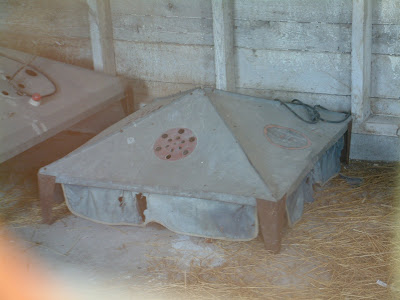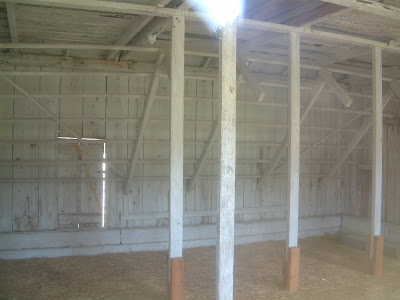The next stop on the tour de coop was the Dechow Farm. This is one of the most impressive farms in Port Oneida, a status that is surely tied to the relatively good soil quality on the farm. The Dechows, and after them the Kletts, also seem to have been smart about how they used their land, devoting a lot of it to pasture for their cattle (which requires less fertile soil than field crops and which cattle happily convert to milk) and investing in a very advanced (for the day) milking operation. This farm was also in operation longer and later than many of the others, so a lot of the buildings are more "modern" and have had less time to decay. Walking around the farmyard, it is easy to "read" how the buildings were used. For views of the rest of the farm, check out the pictures at the link above. I was focused (perhaps a little obsessively) on chickens.
In addition to their milking operation, the Dechows/Kletts kept the most chickens of any family in Port Oneida. That is instantly apparent from the size of the first coop, which is variously referred to in the literature as a brooder and as the broiler (i.e., meat bird) coop. From across the yard, it is easy to spot. Distinctive coop architecture: check. Orientation to the south: check.
Coming around to the other side, lots of details confirm it as the coop.
Three pop doors in all, one peeking coyly from behind the gate to nowhere:
Another whose sill is worn in a pattern that tells of many years of chicken comings and goings:
The south-facing windows are still at least partly sheathed in chicken wire of various gauges and vintages:
Taking pictures through the windows is an exercise in approximation. The lens must be pressed flat against the glass, which severely limits the field of photographable vision. A free hand cupped around the lens helps to minimize glare. It took me several tries to capture a decent image, but finally I got an acceptable shot of what appears to be a couple of old brooder hoods:
I've never seen anything like this before, but my experience of brooding chicks tells me that this canvas(?) hood was fitted with lights for heat and would have been placed over a pen full of chicks to keep them warm. I love the slightly carnivalesque feeling of the tent-like hood. I also love the detail on the two cupolas:
A little searching yields an interesting site about the Hex Signs of the Pennsylvania Dutch and tells me the 8-pointed star proclaims abundance and good will for all. Good symbol for a coop!
The other coop stands behind the big barn and I'm embarrassed to say that on my first visit I was so taken with the first coop that I entirely overlooked the second. So much for my agri-anthro-archi-archaeological skills. But on a second visit, I make its acquaintance. Looking now at the photographs, I cut myself a little slack for having missed it. Aside from its south-facing orientation, it looks nothing like the rest of the Port Oneida coops and is practically barn-like in its scale.
It is much rougher than its mate and the pop doors are comparatively enormous. But a peek through a crack between door and jamb yields an only partially obscured view of a lovely old galvanized nesting box set-up:
While there, I paused to document the "hardware" on the door and noticed a massive number of bees swarming in through the crack.
A trans-window shot shows a rather clever roost, hinged so that it can be raised (as it is in the photo) to allow cleaning of the inevitably high-soil area underneath.
There is something especially poignant about the hardware on these old buildings. This was not on either of the coops, but I found it winsome:
Later on my first day of reconnaissance I paid a visit to the Kelderhouse/Port Oneida Cemetery. The names of the founding families appear regularly--like a rhythmic pulse--but forming different chords as they combine first with this family and then with another. I notice there are both Dechows and Dagos in the cemetery but I haven't encountered the Dagos in my research and I'm having trouble figuring out the ethnicity of that name. The mystery clears when I find a stone that combines both names:
Frederick and Fredericka Dechow travelled the same route as the Burfiends, leaving Germany in 1853 and stopping off in Buffalo before arriving in Michigan in 1857. Like the Burfiends, they started in a log cabin in a different spot on their property. Their grandson Frank, who by then had made the switch to Dago, built the current house in 1910. Twenty-five years later Frank Dago traded the farm, which then consisted of almost 300 unusually fertile acres, a lovely house, all the farm buildings and a sugar shack (don't get me started on the unparalleled deliciousness of Michigan maple syrup!)...in other words, paradise...for a gas station in Detroit. Yes, folks, you read that right.
I can only imagine that in 1935, farming must have seemed awfully hard and the rewards tenuous. The automobile was the future and a gas station was probably a very sound investment. The historical record is silent on what happened to poor Frank in the big city (although his brother's 1945 obit lists Frank as living in Detroit still) but the city slicker with whom he traded (Mr. McGaughlin) lasted only a few years in Port Oneida. In the late 1930s, Elmer Klett, who had been a farmhand for the Dechows, bought the property and improved it. The Kletts were the first Port Oneida family to have electricity--in 1941!














No comments:
Post a Comment